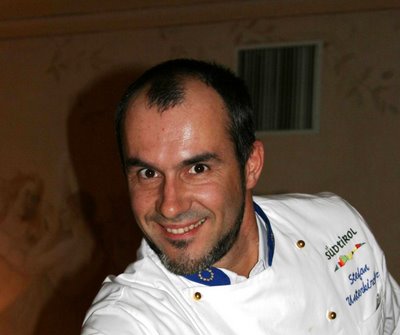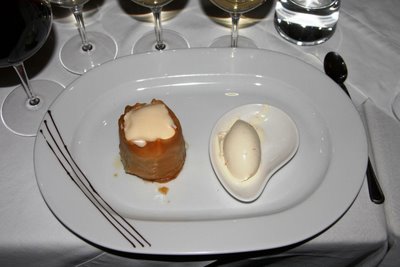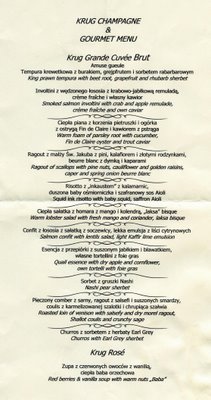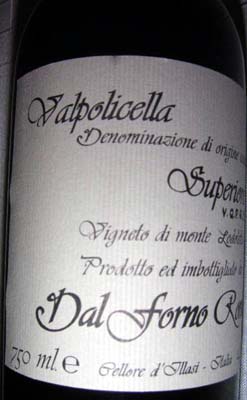Alto Adige wines are a bit like Volkswagen cars. They offer no passionate romantic emotions (at least to me) but embody the notion of ‘consistent quality’. You always know what to expect and you are never disappointed. Sometimes I wish they showed, as do their neighbours from the region of Trentino, a bit of wildness at heart and irrational genius, but I appreciate the fact that in many real life situations, Alto Adige wines are a safe and satisfying choice.
 Chef Stefan Unterkircher.
Chef Stefan Unterkircher.
Never more so than at a restaurant when for any reason, a more adventurous choice is not available. Tonight’s dinner at the
San Lorenzo restaurant in Warsaw, organised by the EOS Alto Adige chamber of commerce, was a good reminder of that adage. Plus we’ve had the bonus of sampling the culinary creations of South Tyrolian chef Stefan Unterkircher, normally in residence at the Castel Ringberg restaurant in Caldaro.
Unterkircher was here to train Polish chefs under an EU programme. If they can deliver this kind of cooking in Poland during my lifetime, I’ll be a very happy man. This was simply excellent food. Simple, flavourful, respectful, exuding experience and freedom at the stoves. Freedom and panache is what Polish chefs most often lack; some have great ideas but just lack the seamlessness that only comes with generations of quality cooking and table service, I think.
Below are my notes on the wines tasted without and with food, as were taken during the dinner.

Cantina Produttori Caldaro Pinot Bianco Vial 2007
This is an impressive if really austere, rock-solid, limestoney, dolomitic wine, with a vague soapy character of Pinot Bianco. Acidity is high, there is a rigidity of the 2007 vintage, and on its own it is not showing very friendly.
With cannelloni of IGP speck and IGP apples, grilled dumplings, caraway foam: the tricky part is the featherlight mousse of caraway and gorgonzola, just slightly overpowering the unaromatic Pinot (if a feather can overpower). Good match with the speck-wrapped mild apple, and sufficiently structured (in fact surprisingly so) with the fried canaderlo dumpling.
Elena Walch Pinot Grigio Castel Ringberg 2007
Oaky, rich and butterscotchy, pronounced varietal character but uncomplex at the stage. Palate is rich with a flavour of cereals and baked apple but also a surprising, seary acidity. This has a really odd balance between oak and acids. Not really my style of white, clearly good but a bit heavy-handed without food.
With ravioli of potatoes and dried pears filled with Stelvio DOP cheese and melted butter: Here the acidity is very useful to cut through the beurre noir oxidative richness of the dish. (Take a sip of the above Pinot Bianco to see how tricky this dish is: wine becomes opaque, fruitless and dusty). This Grigio seems almost capable of addressing a wild boar. Impressive match.
J. Hofstätter Gewürztraminer Kolbenhof 2007
A fantastic wine, consistent with several tastings since summer 2008: its usual flowery, exotic self with excellent acidity courtesy of the 2007 vintage. Long, structured, moderately fat for Gewürz, the balance is truly unique: I can’t think of a Traminer this mineral and refreshing.
With fillet of pike perch in black bread crust, creamed Val Venosta cabbage: dish is a little heavy, wine showing high alcohol but otherwise this is a good textural match: very bourgeois and comfy. Interesting counterpoints between the wine’s minerality and flakes of Atlantic sea salt served on the side.
Erste & Neue Lagrein Riserva Puntay 2005
This has the reductive, granitic, wet-basin aromatic austerity of Lagrein, with minor oak in the background. Not a bad wine, with integrated wood and subdued spice. Good acidity, too, and length. Some greenness (as almost all Lagreins in my book). All in all this is very good but perhaps missing the train to excellence.
With beef’s cheek, honey sauce, purée of celeriac and vanilla: An outstanding dish. Very precise cooking with an umami flavour dominating. Match is interesting: bitter cherry core of Lagrein with a hint of caraway matching the obvious spiciness of the dish well, and the wine’s salinity probably the best match for umami.
Cantina Produttori Colterenzio Gewürztraminer Canthus 2007
10.5% alc, 220 g/l sugar. Very varietal, spicy, peppery, with an excellent moment of peach & mango fruit. Even when served quite warm this is never flabby or sticky. Excellent balance. 3.3
With ‘Pink Lady’ apple in French pastry, Gewürztraminer foam, crème fraîche sherbet: As often at gourmet dinners, dessert is the highlight, exuding quality ingredients and a sense of luxure. The sour cream sherbet is a really fantastic match with the similarly rustic, almost animal acidity of the wine. An outstanding combination.
 ‘Pink Lady’ apple in French pastry, Gewürztraminer foam, crème fraîche sherbet.
‘Pink Lady’ apple in French pastry, Gewürztraminer foam, crème fraîche sherbet.
An outstanding dessert.


 Chef Stefan Unterkircher.
Chef Stefan Unterkircher.


 A taster’s treat tonight. A Krug champagne dinner cooked by Poland’s best chef, Paweł Oszczyk at the Régina hotel in Warsaw. Nominally this dinner was for the launch of the Krug Rosé in Poland, although we drank the Grande Cuvée Brut for most of the evening (and started, atypically, with a most pleasant glass of Cloudy Bay Sauvignon Blanc 2007; Cloudy Bay and Krug belong to the world’s most glamorous brand conglomerate, Louis Vuitton Moët Hennessy).
A taster’s treat tonight. A Krug champagne dinner cooked by Poland’s best chef, Paweł Oszczyk at the Régina hotel in Warsaw. Nominally this dinner was for the launch of the Krug Rosé in Poland, although we drank the Grande Cuvée Brut for most of the evening (and started, atypically, with a most pleasant glass of Cloudy Bay Sauvignon Blanc 2007; Cloudy Bay and Krug belong to the world’s most glamorous brand conglomerate, Louis Vuitton Moët Hennessy).
